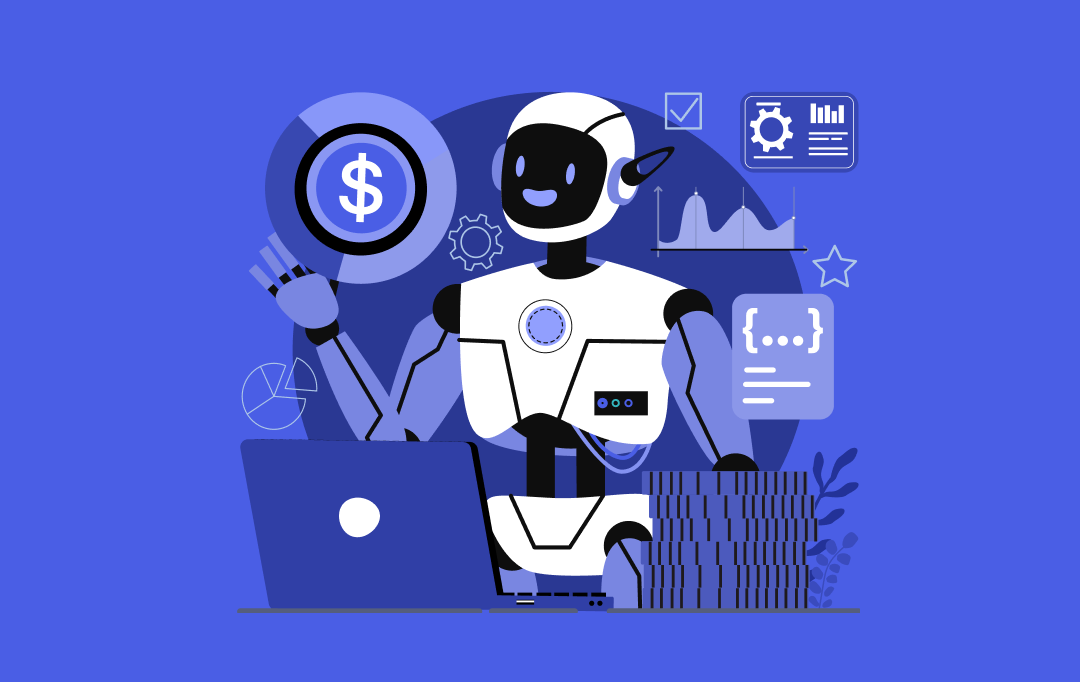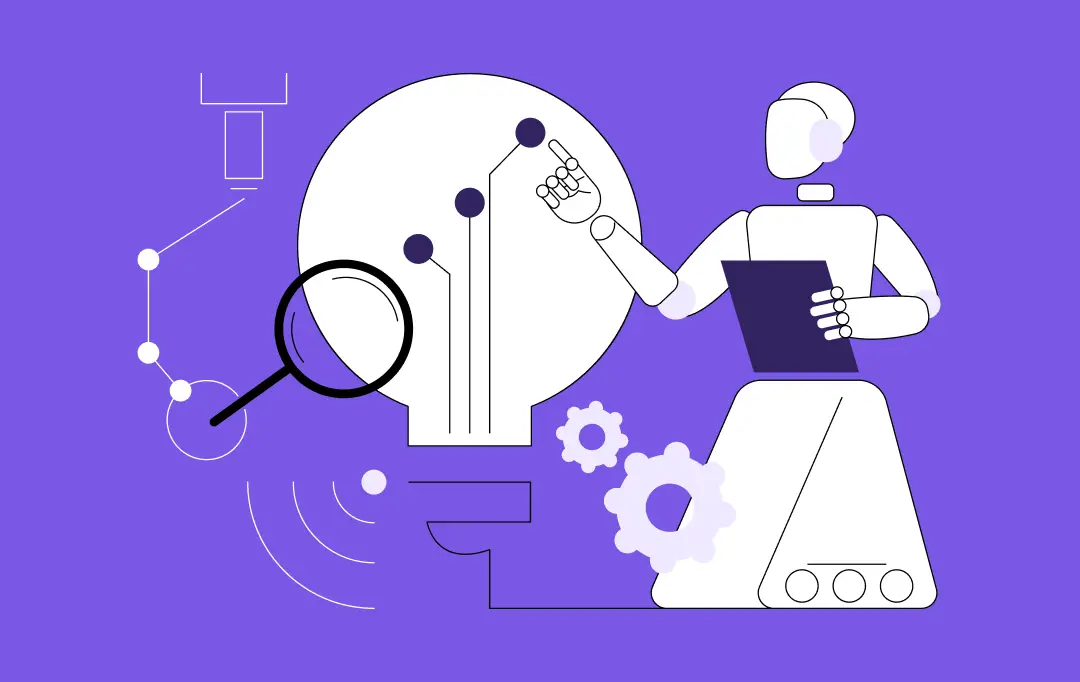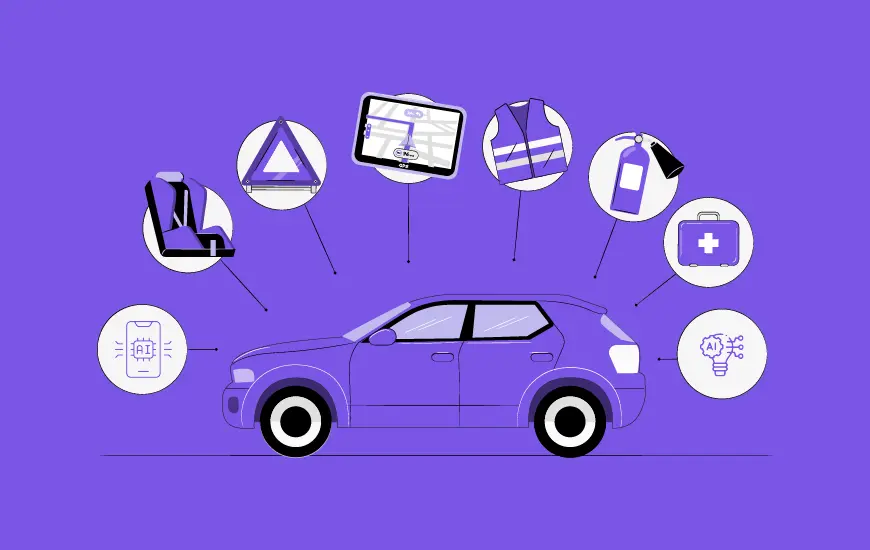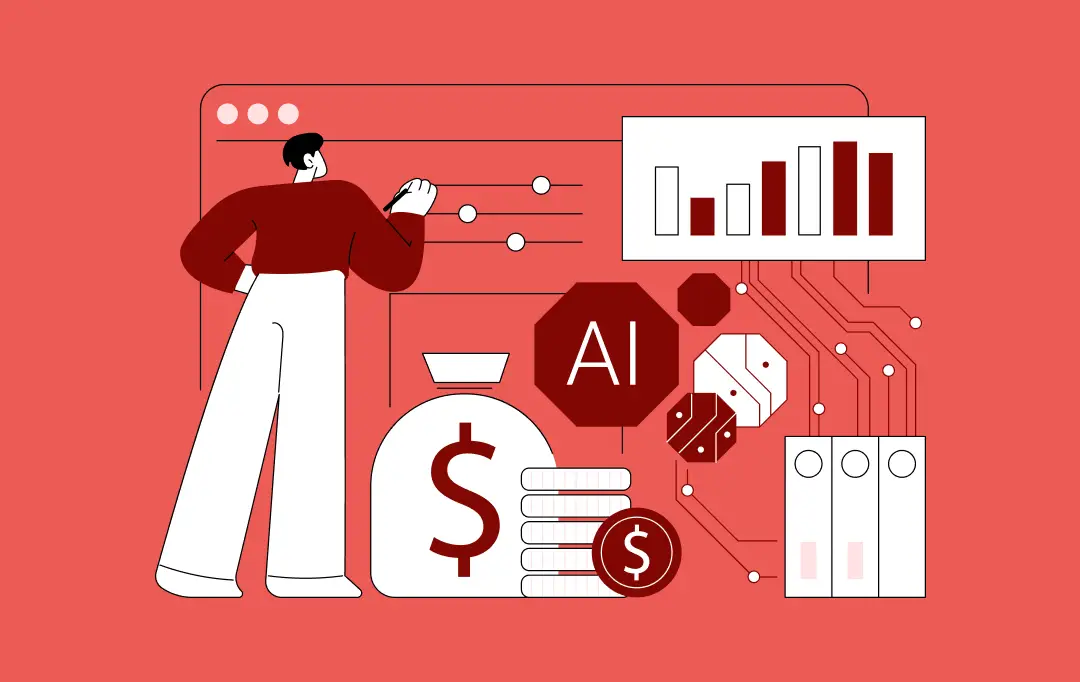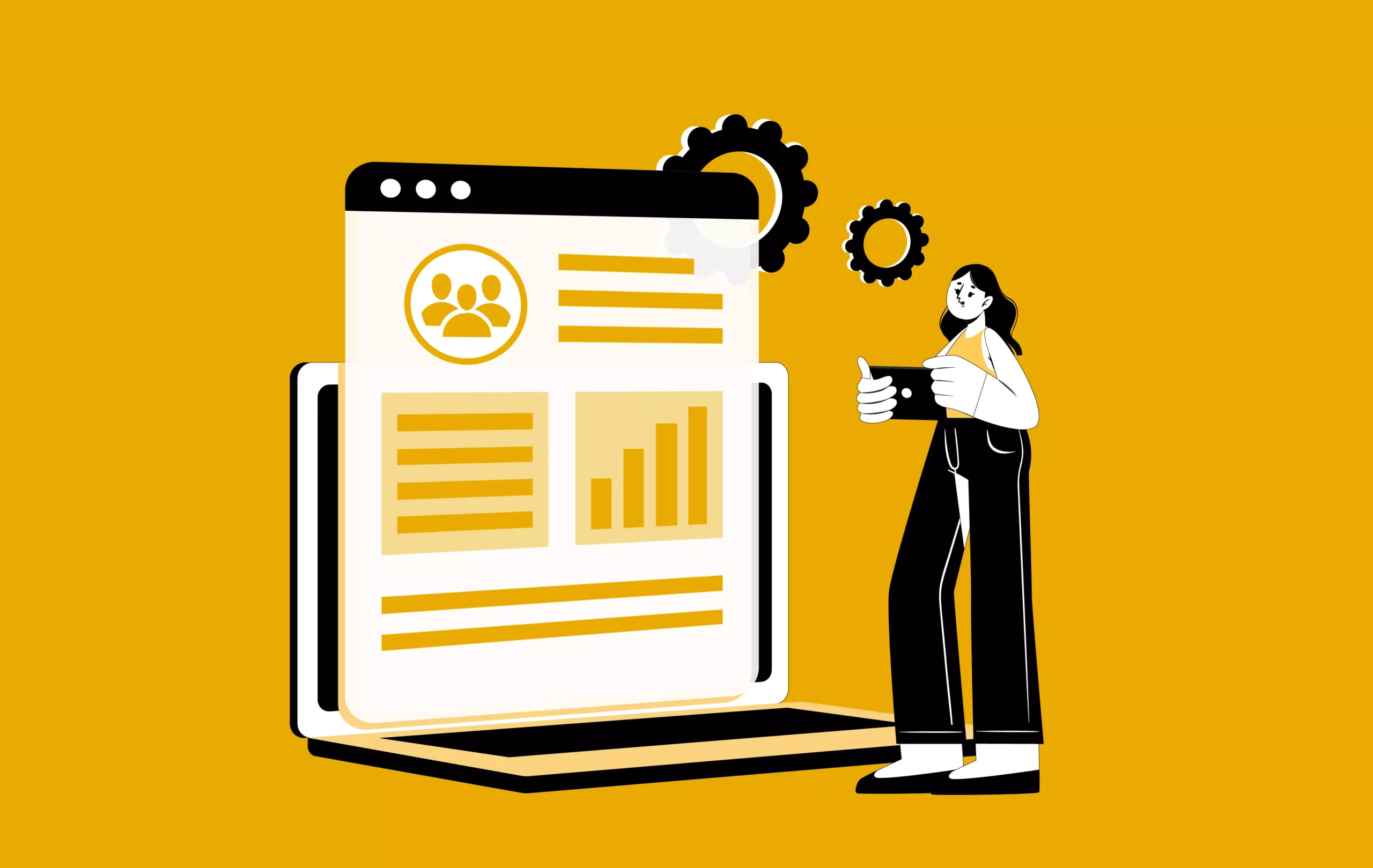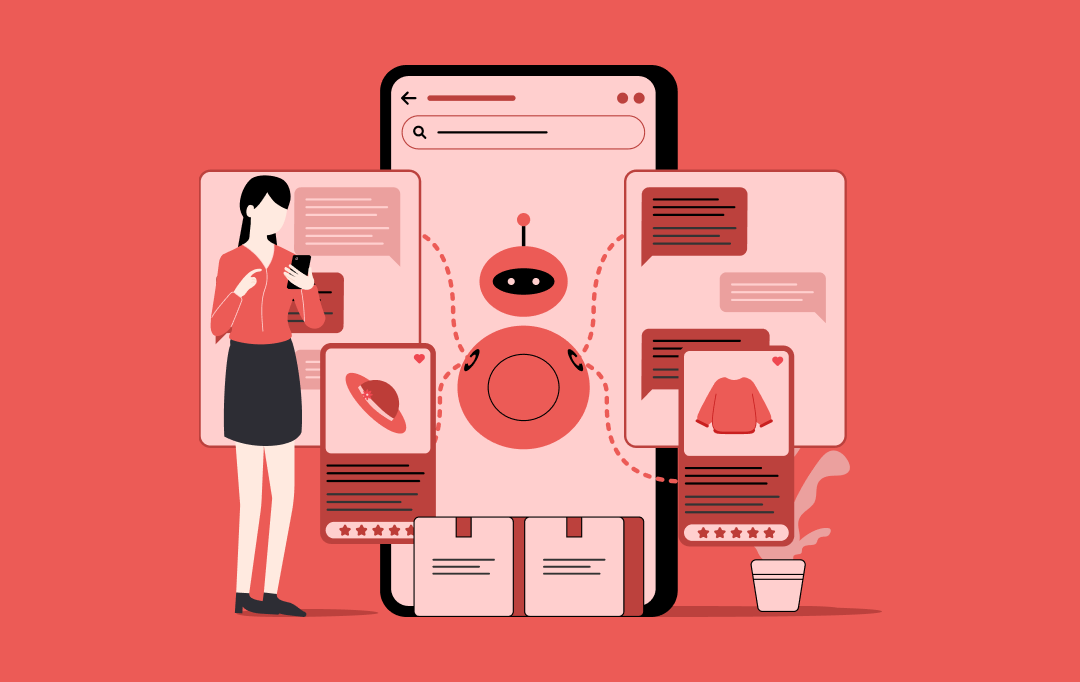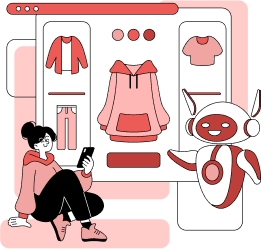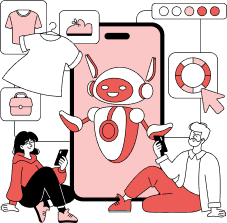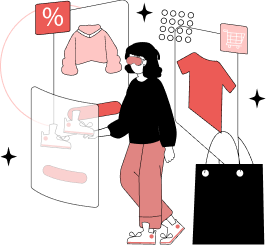- AI Revolutionizing the Fashion Industry: 12 Developments To Watch For
- AI-Powered Fashion Design: Where Creativity Meets Intelligence
- Predictive Analytics for Fashion Trends: Forecasting the Future of Style
- Personalized Shopping Experiences: AI for Personalized Fashion Recommendations
- Virtual Try-Ons and Augmented Reality: Bridging Physical and Digital Fashion
- AI in Fashion Production: Optimizing Manufacturing and Quality Control
- Supply Chain Intelligence: AI-Driven Logistics and Inventory Management
- AI in Fashion Marketing: Targeted Campaigns and Customer Insights
- Dynamic Pricing and Revenue Optimization
- Sustainability and Waste Reduction Through AI
- AI-Powered Customer Service and Support
- AI-Driven Body Measurement and Fit Technology: Revolutionizing Sizing Accuracy
- AI in Fashion Retail Analytics and Store Optimization: Maximizing Physical Retail Performance
- Implementation Strategies for Fashion Industry Leaders
- How Appinventiv Can Help You With AI Integration in the Fashion Industry
- FAQs
Key takeaways:
- AI in fashion is booming, with a market value of $28.48 billion by 2032 and a 39.43% CAGR. It’s transforming design, trends, shopping, manufacturing, and customer service.
- Top brands like Zara and H&M report 200% higher conversions, 64% fewer returns, and 25% better retention.
- Success demands strategy, data infrastructure, and phased AI integration for seamless operations.
- The future of fashion lies in blending AI with creativity, ensuring both innovation and personalization drive business growth.
Ever walked into a store and thought, “Wow, this place gets me”? Or maybe you’ve dreamed of a personal stylist who somehow knows your style better than you do? And what about clothes made without a ton of waste?
Turns out, this isn’t some futuristic fantasy. AI in the fashion industry is making it happen in the fashion world, right now.
Think about it. Fashion used to be all about gut feelings and cool ideas. But things are changing, and fast. We’re seeing a huge shift. Every part of the fashion business, from how clothes are designed to how they’re sold in stores, is getting an AI upgrade.
And get this: AI isn’t just about making things automatic. It’s building a whole new experience. We’re talking smarter, more personal, and even more eco-friendly fashion for everyone – both brands and shoppers like us.
As a decision maker, grasping how AI in the fashion industry is transforming the way we design and sell can feel like an exciting leap into the future. It’s not just about keeping up with the latest styles—it’s about unlocking new ways to grow your business, streamline operations, and connect with customers like never before.
Hence, this blog will discuss 12 creative approaches to AI implementation in the fashion industry, followed by implementation strategies for decision makers embracing artificial intelligence.
AI Revolutionizing the Fashion Industry: 12 Developments To Watch For
According to Statista, the market value of AI in the fashion industry is projected to reach $4.4 billion by 2027, growing at a remarkable CAGR of 36.9%. Meanwhile, Straits Research indicates that the global AI in fashion market was valued at USD 1.99 billion in 2024 and is estimated to reach USD 39.71 billion by 2033, growing at a CAGR of 39.43%.
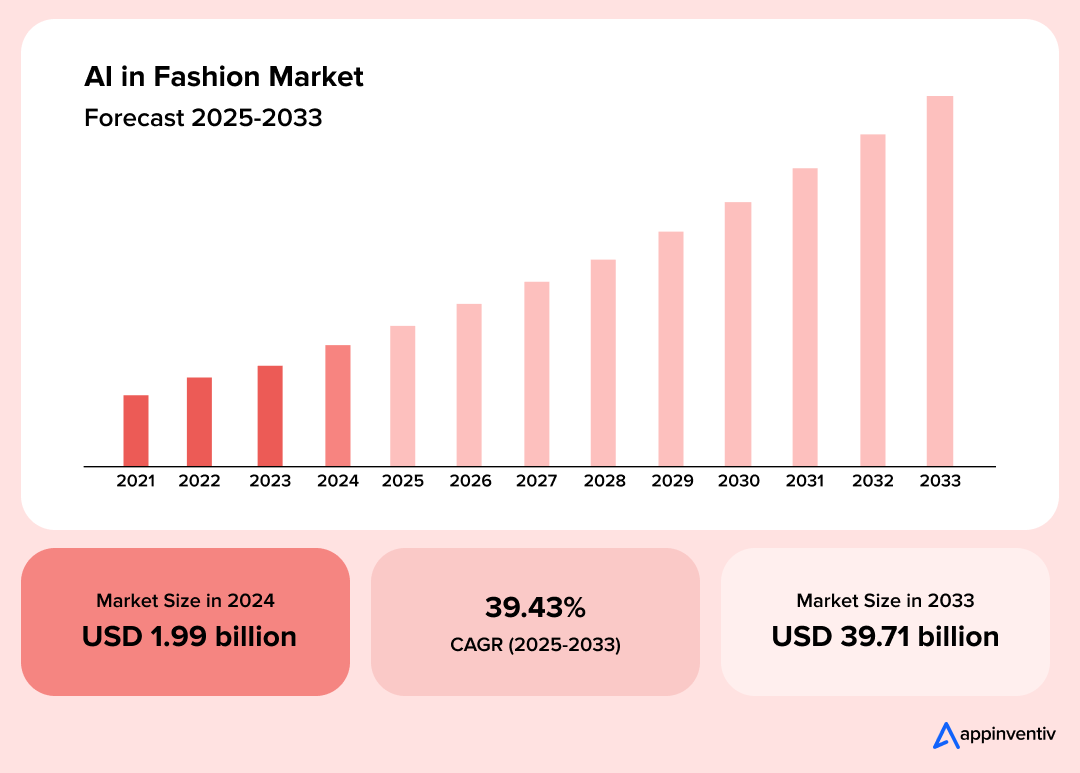
These aren’t just numbers; they represent a fundamental shift in how fashion businesses operate and compete.
AI fashion is no longer a niche tool or a passing trend; it has become the catalyst driving the future of fashion technology. As C-level executives in fashion, understanding and embracing this technological revolution is no longer optional; it’s essential for survival and growth in an increasingly digital-first world.
Let’s dive into 12 Revolutionary ways AI is impacting the fashion industry.
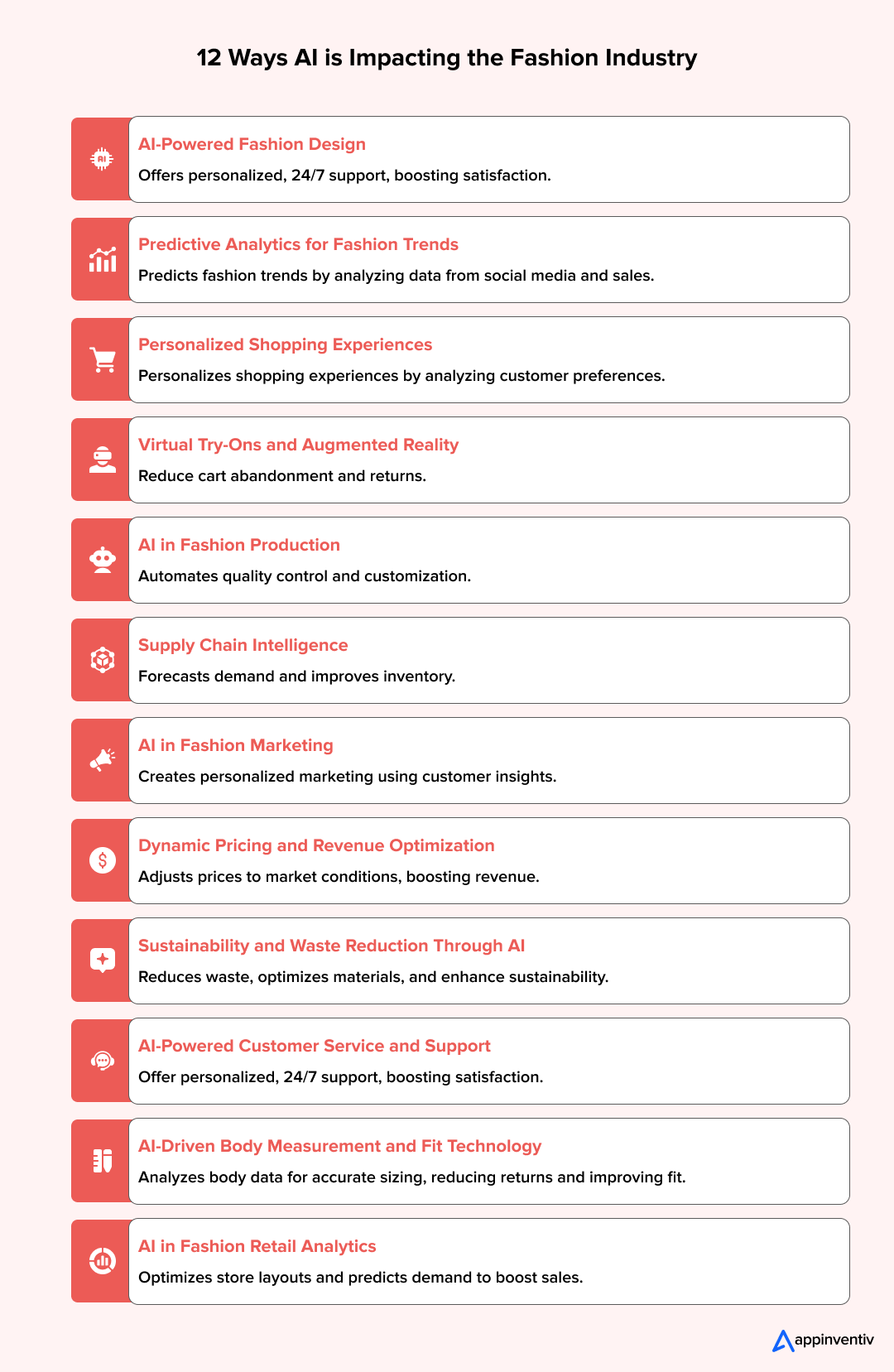 AI is revolutionising the fashion industry, optimizing operations, improving customer experiences, and driving growth. It empowers brands to stay ahead with data-driven insights, smarter processes, and more sustainable practices.
AI is revolutionising the fashion industry, optimizing operations, improving customer experiences, and driving growth. It empowers brands to stay ahead with data-driven insights, smarter processes, and more sustainable practices.
AI-Powered Fashion Design: Where Creativity Meets Intelligence
The way fashion gets designed is changing, thanks to AI. Designers can now be more creative and efficient simultaneously. AI in fashion design is revolutionising the process of bringing new ideas to life, from the initial spark to the finished product. It’s like human creativity and machine accuracy are working together perfectly.
Think about it: new AI-driven fashion innovations let designers look through thousands of designs, colour mixes, and trend ideas in seconds. This used to take weeks! How? Well, special AI programs analyze huge amounts of old-fashioned data, what’s trending on social media, and even cultural influences. This helps them suggest designs that really connect with the people who will wear them.
Real-World Example: Tommy Hilfiger created their “Reimagine Retail” platform, which analyzes social media trends and customer preferences to inform design decisions. The AI system helped create their Fall 2018 collection by analyzing over 600,000 street style images and identifying trending colours, patterns, and silhouettes.
- Generative AI fashion tools create entirely new design concepts based on specific parameters like target demographics, seasonal themes, or brand aesthetics. AI in fashion design algorithms optimize pattern layouts to minimise fabric waste, suggest material combinations that enhance durability, and predict how designs will look on different body types.
For executives considering building AI apps for their fashion brands, the design application represents one of the most immediately valuable implementations. AI-powered design tools can significantly reduce time-to-market for new collections while improving design quality and market relevance.
Predictive Analytics for Fashion Trends: Forecasting the Future of Style
AI Fashion trends’ prediction has emerged as one of the most strategic applications of AI in the fashion industry. The ability to accurately forecast upcoming trends provides fashion brands with a significant competitive advantage in a market where timing is crucial.
Traditional trend forecasting relied heavily on human intuition and limited data sources. According to The Wall Street Journal, LVMH is leveraging predictive AI, generative AI, and AI agents to enhance various business operations, including supply chain planning, pricing, product design, marketing, and personalization.
Today’s AI Fashion systems analyze millions of data points from social media platforms, fashion shows, street style photography, celebrity appearances, and consumer behaviour patterns to identify emerging trends months before they become mainstream.
Real-World Example: Zara uses AI Fashion trends forecasting through their partnership with tech companies to analyze Instagram posts, Pinterest boards, and fashion blogs. Their AI system can identify emerging colour trends and popular silhouettes, enabling Zara to design and produce new items in just 2-3 weeks, instead of the industry standard of 6 months.
- Machine learning algorithms excel at pattern recognition, identifying subtle signals that indicate rising AI Fashion trends. These systems analyze the frequency of specific colours in fashion influencer posts, track silhouette popularity across demographics, and predict seasonal demand for product categories.
Personalized Shopping Experiences: AI for Personalized Fashion Recommendations
The days of generic shopping are over. We’re now in an era where AI in the fashion industry is making everything custom-fit. This means that every customer gets a shopping experience tailored to their unique needs.
AI for personalized fashion recommendations is totally changing how we find and buy clothes. It makes you more interested in what you’re seeing, and it helps businesses make more sales.
Today’s AI for personalized fashion recommendations systems do way more than just suggest “customers who bought this also bought” items. These smart programs look at everything:
- What you browse online
- What you’ve bought before
- Your personal style
- Even your body measurements
- And how you live your life
All of this helps create a comprehensive picture of you, so the recommendations are spot on.
Real-World Example: Stitch Fix revolutionized personal shopping with AI for personalized fashion recommendations. Their algorithms analyze over 85 data points per customer, including style preferences, fit feedback, and lifestyle needs. Combined with human stylists, their AI system has served over 4 million customers and maintains a higher retention rate than traditional fashion retailers.
- The technology leverages multiple AI for fashion techniques simultaneously. Computer vision algorithms analyze visual characteristics of items customers view and purchase, identifying preferences for colours, patterns, and styles. Natural language processing examines customer reviews to understand satisfaction patterns.
- Brands implementing AI-powered app development strategies for personalization typically see increases in conversion rates, average order values, and customer lifetime value. The personalized experience creates stronger emotional connections between customers and brands.
Virtual Try-Ons and Augmented Reality: Bridging Physical and Digital Fashion
One of the biggest headaches with online fashion shopping? Not being able to try things on! But now, thanks to virtual try-on technology powered by AI for fashion, that problem is disappearing. How? Through cool apps that use a mix of computer vision, machine learning, and augmented reality.
This technology uses AI for fashion algorithms to virtually “put” clothes onto your picture or a digital avatar, all in real-time. Even better, the advanced systems can adjust for different body types, sizes, and even how you’re posing. This means you get a super accurate look at how something will fit and appear on you.
Real-World Example: Sephora’s Virtual Artist app uses AI and AR to let customers try on makeup virtually. The technology has been so successful that it increased conversion rates and reduced product returns. Similarly, Warby Parker’s virtual try-on for eyewear has helped them become a billion-dollar company by solving the fit problem for online eyewear shopping.
- According to Business Research Insights, virtual try-ons and augmented reality are driving significant market growth in the fashion sector. AI in fashion retail, through virtual try-ons, addresses multiple pain points simultaneously, such as customers gaining confidence in their purchases, reducing hesitation, and preventing cart abandonment.
- Retailers benefit from reduced return rates and increased conversion rates. The future of fashion technology includes even more advanced capabilities. Emerging systems simulate how fabrics move and drape, predict colour accuracy under various lighting conditions, and show how clothing items will look after wear and washing.
AI in Fashion Production: Optimizing Manufacturing and Quality Control
AI in fashion production is revolutionizing manufacturing processes, bringing unprecedented levels of efficiency, quality control, and customization to fashion production lines. This application of artificial intelligence in the fashion industry addresses critical challenges, including quality consistency, production speed, and waste reduction.
Modern AI systems utilises computer vision to inspect products at various stages of production. These systems detect defects, inconsistencies, and quality issues far more accurately and consistently than human inspectors.
Real-World Example: One prominent case is Ekoten, a leading textile manufacturer in Turkey, which implemented real-time AI inspection across its production lines. By integrating it, Ekoten achieved an 80% reduction in defective fabric production. The AI system detects defects early in the manufacturing process, preventing the production of over 4.5 tons of raw fabric annually.
- AI monitors how equipment is performing and can predict when something might break down before it happens. This means less time the machines are sitting idle, lower repair costs, and consistently good product quality.
- AI enables the creation of custom clothing on a massive scale. Smart manufacturing systems can instantly tweak how things are made to handle special orders. And the best part? It doesn’t disrupt the entire production line. This is a big deal as more and more of us want personalized products.
- AI algorithms are here to help optimize production schedules. These systems juggle everything at once: determining which orders are most important, checking if materials are on hand, assessing the availability of equipment, and determining when everything needs to be delivered. It’s all about utilising manufacturing resources in the most efficient way possible.
The AI fashion market is projected to reach $39.71 billion by 2033. Ready to ride the wave of innovation?
Supply Chain Intelligence: AI-Driven Logistics and Inventory Management
Managing the supply chain in the fashion industry is challenging. You’ve got to deal with things like:
- Seasonal changes in what people want.
- Keeping up with fast-moving trends for inventory.
- The headache of sourcing materials from all over the world.
However, AI in fashion retail is transforming how brands address these challenges. It’s making supply chains much quicker to respond and way more efficient.
Fashion AI powered demand forecasting systems can predict what inventory you’ll need with amazing accuracy. How? They look at tons of data, like:
- Past sales numbers.
- What trends are coming next?
- Economic signs.
- Even weather patterns.
- And what people are saying on social media.
Real-World Example: H&M implemented fashion AI supply chain management that analyzes sales data, returns, and local preferences to optimize inventory distribution across their 5,000+ stores worldwide. Their AI system reduced inventory waste and improved product availability by predicting demand patterns more accurately than traditional methods.
- Getting clothes from the factory to your closet involves a lot of moving parts. But intelligent routing and logistics optimization, powered by AI for fashion algorithms, makes the whole process smoother. These systems work to find the best shipping routes, combine orders to save space and money, and coordinate different ways of transport.
- AI algorithms keep a close eye on everything: how suppliers are performing, where shipments are at all times, and potential problems that could disrupt the process before they even reach customers.
- AI enables more sustainable supply chain practices. Intelligent systems optimize transportation to reduce carbon emissions, identify opportunities for local sourcing, and minimise packaging waste.
According to Straits Research, supply chain management held a dominant market position in the artificial intelligence in the fashion industry market, highlighting AI’s significant impact on operational efficiency.
Bonus Read: AI in Logistics
AI in Fashion Marketing: Targeted Campaigns and Customer Insights
AI in fashion marketing enables brands to create effective marketing campaigns. They become more personal and accomplish tasks efficiently. Think about it: with AI, marketers can look at huge amounts of customer data and even guess how people will act. This gives them amazing tools to find and connect with the right shoppers.
Generative AI fashion marketing tools are completely transforming how fashion brands create their content. These systems can write product descriptions, social media posts, emails, and even ad copy. And the cool part? They ensure the words resonate with various customer groups.
Real-World Example: Burberry partnered with Google to create personalized marketing campaigns using AI in fashion marketing. Their system analyzes customer behaviour across digital touchpoints to create individualised email campaigns and social media ads. This approach increased their email click-through rates by 50% and improved social media engagement by 30%.
- Customer segmentation powered by AI algorithms enables fashion brands to identify micro-segments within their customer base. Instead of broad demographic categories, AI for fashion identifies specific groups based on shopping behaviours, style preferences, price sensitivity, and engagement patterns.
- Predictive analytics in AI in fashion marketing helps brands identify which customers are most likely to respond to specific campaigns, make purchases, or become loyal advocates. This intelligence enables more efficient allocation of marketing budgets.
- Real-time personalization of marketing messages based on AI analysis creates more relevant experiences. When customers visit fashion websites or apps, AI systems instantly customizes content, product recommendations, and promotional offers.
Social media marketing powered by AI for fashion algorithms identifies trending topics, optimal posting times, and influential content creators that align with brand values.
Dynamic Pricing and Revenue Optimization
AI-driven pricing strategies are revolutionizing revenue optimization in the fashion industry, enabling real-time, dynamic pricing that adapts to market conditions, demand, and competition through the use of AI. This application of artificial intelligence in the fashion industry operations maximises profitability while maintaining customer satisfaction.
Machine learning algorithms analyze multiple factors to determine optimal pricing strategies, including competitor pricing, inventory levels, demand forecasts, seasonal trends, and customer price sensitivity. This comprehensive analysis through fashion AI enables fashion brands to set prices that maximise revenue while remaining competitive.
Real-World Example: ASOS uses AI-powered dynamic pricing to optimize revenue across its global operations. Their system analyzes competitor prices, inventory levels, and customer demand in real-time to adjust prices automatically. During their sales periods, the AI can make thousands of price adjustments per day, resulting in a 15% increase in profit margins while maintaining customer satisfaction.
- Real-time price optimization, powered by AI systems, adjusts prices automatically based on changing market conditions. During high-demand periods, prices are optimized to capture maximum value, while during slow periods, strategic price reductions clear inventory and maintain cash flow.
- Personalized pricing strategies enabled by AI in fashion algorithms offer different prices to different customer segments based on purchasing history, loyalty status, and price sensitivity. This approach maximises revenue from high-value customers while maintaining accessibility for price-sensitive segments.
- Markdown optimization through AI analysis helps fashion brands maximise value recovered from unsold inventory. AI systems predict optimal timing and depth of markdowns to clear inventory while minimising revenue loss.
Competitive pricing intelligence powered by AI for fashion brands systems monitors competitor pricing across multiple channels, providing real-time insights into market positioning.
Must Read: 7 Ways Artificial Intelligence is Reshaping the Mobile Economy
Sustainability and Waste Reduction Through AI
Sustainability has become a critical concern for fashion brands and consumers alike, and AI in the fashion industry applications is providing powerful tools for reducing environmental impact while maintaining business performance. These AI-driven fashion innovations address multiple aspects of sustainability from design to disposal.
Design optimizations via fashion AI help fashion brands create products that minimise material waste during production. Algorithms analyze pattern layouts, fabric utilisation, and cutting efficiency to maximise yield from each piece of material.
Must Read: How Artificial Intelligence Can Solve Sustainability Challenges?
Real-World Example: Stella McCartney implemented blockchain-based sustainability tracking throughout their supply chain. Their AI-driven fashion system tracks the environmental impact of each garment, from raw materials to finished product, helping them reduce water usage by 30% and fabric waste by 25% while maintaining design quality and brand aesthetics.
- Demand forecasting accuracy improved by AI algorithms reduces overproduction, one of the fashion industry’s most significant sustainability challenges. By accurately predicting demand, brands produce closer to actual customer needs, reducing unsold inventory that often ends up in landfills.
- Supply chain optimization through AI in fashion systems reduces transportation emissions by optimising shipping routes, consolidating shipments, and selecting more efficient transportation methods. These optimisations contribute to reduced carbon footprints while providing cost savings.
- Circular economy initiatives powered by artificial intelligence in fashion include systems that track garment lifecycles, predict optimal timing for recycling or upcycling, and match used garments with customers seeking specific items. These systems support resale, rental, and recycling programs that extend product lifecycles.
Sustainable material selection assisted by AI in fashion algorithms helps designers choose materials with lower environmental impacts. AI systems analyze the ecological footprints of different materials, considering production energy, water usage, and disposal options.
AI-Powered Customer Service and Support
Customer service in the fashion industry is being transformed by applications of artificial intelligence in fashion that provide 24/7 support, personalized assistance, and proactive problem resolution. These systems enhance customer satisfaction while reducing operational costs for fashion brands.
Intelligent chatbots powered by natural language processing handle a wide range of customer inquiries, including product information, sizing guidance, order status, and return processes. These systems understand context and maintain coherent conversations that feel natural to customers.
Real-World Example: The North Face implemented an AI-powered shopping assistant called “Expert Personal Shopper” (XPS) that uses Watson technology. The chatbot asks customers about their outdoor activities, weather conditions, and preferences to recommend appropriate gear. This AI in fashion system increased customer engagement by 60% and improved sales conversion rates by 40% compared to traditional browsing.
- Visual search capabilities enabled by AI in fashion allow customers to find products by uploading images rather than trying to describe what they’re looking for. This is particularly valuable in fashion AI retail, where customers often see items they like but struggle to describe them effectively.
- Proactive customer service powered by AI algorithms identifies potential issues before customers encounter them. For example, AI systems can predict when a customer might be dissatisfied with a purchase based on browsing behaviour and reach out with assistance or alternatives.
- Personalized support experiences created by AI in fashion analysis of customer history and preferences enable more effective problem resolution. When customers contact support, AI systems provide representatives with comprehensive customer context.
AI-Driven Body Measurement and Fit Technology: Revolutionizing Sizing Accuracy
Sizing inconsistencies remain one of the biggest challenges in fashion retail, with return rates reaching 30-40% primarily due to fit issues. AI in the fashion industry is addressing this critical problem through advanced body measurement and fit prediction technology that creates personalized sizing recommendations with unprecedented accuracy, transforming how customers discover their perfect fit across different brands and styles.
AI in the fashion industry uses smart tech to scan your photos and figure out your exact body measurements, creating a 3D model of you. It understands your shape and style to make sure the clothes you buy online fit perfectly, taking away all the guesswork.
Real-World Example: Aiming for growth in the UK and US, Lucy & Yak, a British fashion brand, partnered with True Fit to enhance online shopping with AI-driven fit recommendations. Using True Fit’s Fashion Genome, which analyzes data from over 82 million shoppers and 20,000+ brands, Lucy & Yak has provided over 294,000 fit recommendations, increasing revenues per user by 541% and doubling conversions (+245%), improving customer experience, loyalty, and reducing size-related returns.
- AI in the fashion industry delves deeper than size charts, studying fabric stretch, garment design, and your unique body shape to recommend clothes that fit perfectly.
- Using just your smartphone, artificial intelligence in fashion creates precise 3D avatars by mapping your body’s contours and posture, refining fit profiles with every purchase or return.
- AI in fashion retail learns from your past purchases across multiple brands to predict the perfect sizing and uses analytics to forecast how clothes will fit over time, considering factors such as fabric wear and body changes.
AI in Fashion Retail Analytics and Store Optimization: Maximizing Physical Retail Performance
Let’s face it: old-school retail stores are struggling in today’s digital world. Traditional methods of managing a shop are no longer sufficient for what modern shoppers expect. But applications of AI in the fashion industry are changing that. They’re transforming how fashion retailers run their physical spaces.
This means they can create more effective store layouts, understand customer behaviour, and even enhance the overall experience when you walk in. It’s all about using real data to create smart plans that push sales and keep customers happy, helping these stores truly compete with online shops.
Real World Example: Uniqlo, under Fast Retailing, actively integrates AI into its physical retail operations to optimize everything from trend forecasting to in-store customer flow. They utilise AI-powered heat mapping to analyze customer movement, dwell times at displays, and product interactions within stores, identifying “hot zones” and “dead zones” to recommend optimal product placement and layout adjustments for improved navigation and maximised sales.
- AI-powered data visualisation and deep customer behaviour analysis help stores create dynamic layouts and put products in just the right spots. This means that when items are seen more, it’s easier for you to find your way around, and sales increase. How? By really understanding how customers move through the store.
- Predictive AI forecasting enables stores to manage their inventory with exceptional accuracy. It examines past sales, new trends, and external factors such as weather conditions. This means less wasted product, fewer empty shelves, and always having what you want in stock.
- AI makes your overall in-store experience better by connecting what stores know about you online with what happens in person. It helps guide special promotions just for you, provides staff assistance, and creates a more relevant shopping trip every time.
23% of the AI fashion market is focused on supply chain intelligence—adopt AI now for better demand forecasting and logistics!
Implementation Strategies for Fashion Industry Leaders
Successfully implementing AI for fashion brands requires strategic planning that balances technological capabilities with business objectives. For C-level executives, developing a comprehensive AI strategy is essential for capturing the transformative potential of these technologies. The use of AI in fashion must be approached systematically to ensure successful adoption and maximum return on investment.
| Step | Description | Action |
|---|---|---|
| AI Implementation Assessment | Conduct a thorough assessment of current business processes and identify areas where AI for fashion brands can provide the greatest impact, focusing on both operational efficiency and customer experience enhancements. | Identify AI opportunities for operational efficiency and customer experience. |
| Technology Infrastructure Evaluation | Evaluate the technology infrastructure, ensuring data collection, storage, and processing capabilities are robust enough to support fashion AI. This might require upgrades or migration to cloud-based platforms. | Ensure systems are capable of supporting AI algorithms and upgrade as needed. |
| Data Strategy Development | Develop a comprehensive data strategy that ensures data quality, collection practices, and governance frameworks to protect customer privacy while enabling use of AI in fashion applications. | Establish data collection, quality, and privacy practices for AI success. |
| Talent Acquisition and Training | Address the skill gap in fashion AI implementation by hiring AI specialists, training existing staff, or partnering with external experts familiar with both AI technologies and fashion industry dynamics. | Hire/train staff or partner with external experts in AI and fashion. |
| Pilot Program Development | Test AI applications on a smaller scale through pilot programs to gain insights into system performance, user acceptance, and business impact, reducing risk and investment before full implementation. | Run smaller-scale tests to assess AI effectiveness before full implementation. |
| Partnership Strategies | Form partnerships with technology providers to accelerate AI in fashion implementation and reduce internal resource requirements. Collaborate with experienced AI companies to gain access to proven technologies and expertise. | Collaborate with AI solution providers for faster and efficient deployment. |
The future of fashion technology hinges on how effectively brands can integrate these AI solutions into their existing operations while preserving the creativity and human touch that define the fashion industry. The successful use of AI in fashion requires striking a balance between technological capabilities, brand identity, and customer expectations.
Fashion AI implementations should focus on enhancing rather than replacing human creativity and expertise. The most successful fashion brands are those that utilise technology to enhance human capabilities rather than replace them entirely.
How Appinventiv Can Help You With AI Integration in the Fashion Industry
As the fashion industry rapidly embraces artificial intelligence as fashion AI, partnering with the right technology company becomes crucial for successful implementation. Appinventiv stands at the forefront of AI innovation, offering comprehensive AI services that transform fashion businesses through intelligent technology solutions.
Our team of AI specialists brings deep expertise in fashion industry challenges, from trend prediction and personalized recommendations to supply chain optimization and customer experience enhancement. With over 1,600 tech experts and numerous accolades, including recognition in the Deloitte Tech Fast 50, consecutively for two years (2023 and 2024), we are well-equipped to tackle complex industry needs. We understand that successful AI implementation requires more than just technology; it demands strategic thinking, industry knowledge, and seamless integration with existing systems.
A prime example of our fashion industry expertise is our work with Adidas, where we helped the global sports merchandise giant transition from a web-centric approach to a mobile-first strategy. Facing the challenge of reaching their predominantly millennial customer base through mobile platforms, Adidas partnered with Appinventiv to develop a comprehensive eCommerce mobile application.
The results were remarkable: 2 million downloads and 500,000 new users acquired, significantly expanding their mobile presence and driving growth within their target market.
Alongside, we have also worked for IKEA, KFC, The 6th Street, and the list goes on.
We share our relevant experience in AI development services:
- Proven track record in AI development across multiple industries, delivering measurable results for global clients.
- Comprehensive AI consulting services from strategy development to full-scale implementation.
- Collaborative approach to AI integration, working closely with your team for tailored solutions.
- Expertise in implementing personalized shopping experiences, optimizing production, and enhancing customer service.
- Ongoing support for continuous optimization to ensure successful outcomes.
FAQs
Q. How is AI changing the fashion industry?
A. AI is transforming the fashion industry, and it’s fascinating to observe. Think about shopping online – frustrating, right? You scroll through hundreds of items that don’t match your style. However, AI is becoming increasingly adept at determining what you want. It’s like having a personal shopper who knows your taste. Behind the scenes, stores used to guess how much inventory they needed. Sometimes they’d run out. Other times? Warehouses full of unwanted clothes. Now AI predicts this stuff. It’s like having a crystal ball for trends. For designers, AI handles the boring work – analyzing photos, sorting feedback, and tracking sales.
The result? More time for creating. It’s not about replacing creativity. It’s about making fashion smarter. Less waste. Better fits. Clothes people actually want.
Q. How does AI influence fashion trends?
A. AI is changing how fashion trends work. And it’s pretty smart about it. These systems dig through tons of data – social media posts, shopping habits, what influencers are wearing. They’re basically trend detectives. Instead of designers guessing what’ll be popular next season, AI spots the patterns early. It’s like having a friend who always knows what’s cool before everyone else. I saw one brand use AI to track which colors were trending on Instagram. Turns out, people were posting way more sage green outfits than anyone realised.
The result? Their sage green collection sold out in weeks. Predictive analytics help designers create stuff they know people will want. No more crossing fingers and hoping. Less waste too. Because when you can predict demand, you make exactly what sells. It’s about timing. Getting the right styles to market when people actually want them.
Q. How is AI impacting the fashion industry?
A. AI is shaking up fashion in ways that actually matter. Your shopping experience? Way more personal now. These systems study what you buy, what you click, even what you return. Then they show you stuff you’ll want. It’s like having a friend who knows your style perfectly. Behind the scenes, things are getting smarter too. Stores used to order way too much or way too little. Now, AI predicts exactly what will sell. Less waste. Better profits.
And for designers? AI handles the boring stuff – sorting through trend data, analyzing colours, tracking what’s popular where. This frees them up to do what they do best: create cool clothes. I heard about one designer who used to spend hours researching fabric trends manually. Now AI does it in minutes. She focuses on the fun part – designing. The whole system works better. Brands make what people want. Stores stock the right amounts. Customers find clothes they love faster. It’s not rocket science. It’s just… smarter fashion.
Q. What are the benefits of AI in the fashion industry?
A. AI is changing fashion. And it’s working pretty well. When you shop online now, suggestions actually make sense. No more random stuff that doesn’t match your style. These systems learn what you like and show you clothes you’ll actually wear. Stores used to guess what to order. Sometimes tons of ugly sweaters nobody wanted. Other times? That perfect jacket sold out in your size. Now AI predicts this stuff. Less waste. Better timing.
For designers, AI handles the research grunt work. Instead of spending weeks figuring out trending colors, they get that info instantly. More time for creating. I saw one brand cut overstock by 40% just by letting AI predict demand. Trend forecasting happens in real-time too. No waiting months to see if something’s popular. AI spots it as it happens. The result? Brands make what people want. When they want it. Pretty simple.
Q. How AI is transforming fashion design?
A. AI is taking over the boring parts of fashion design. And that’s actually great news. Designers used to spend hours creating patterns by hand. Now AI does it in minutes. This frees them up for the fun stuff – being creative. These tools study what customers buy and predict what they’ll want next season. It’s like having a crystal ball for trends. AI can even suggest new fabric patterns and color combos based on tons of data.
The cool part? It’s making fashion more sustainable too. Instead of wasting materials, AI figures out the smartest way to cut fabric. Less waste. Better designs. I read about one designer who used AI to create patterns inspired by ocean waves. The AI analysed thousands of wave photos and generated unique designs she never would have thought of. The whole process moves faster now. From idea to finished collection in half the time. More fresh styles hitting stores. More stuff people actually want to wear.


Get started now!
- In just 2 mins you will get a response
- Your idea is 100% protected by our Non Disclosure Agreement.
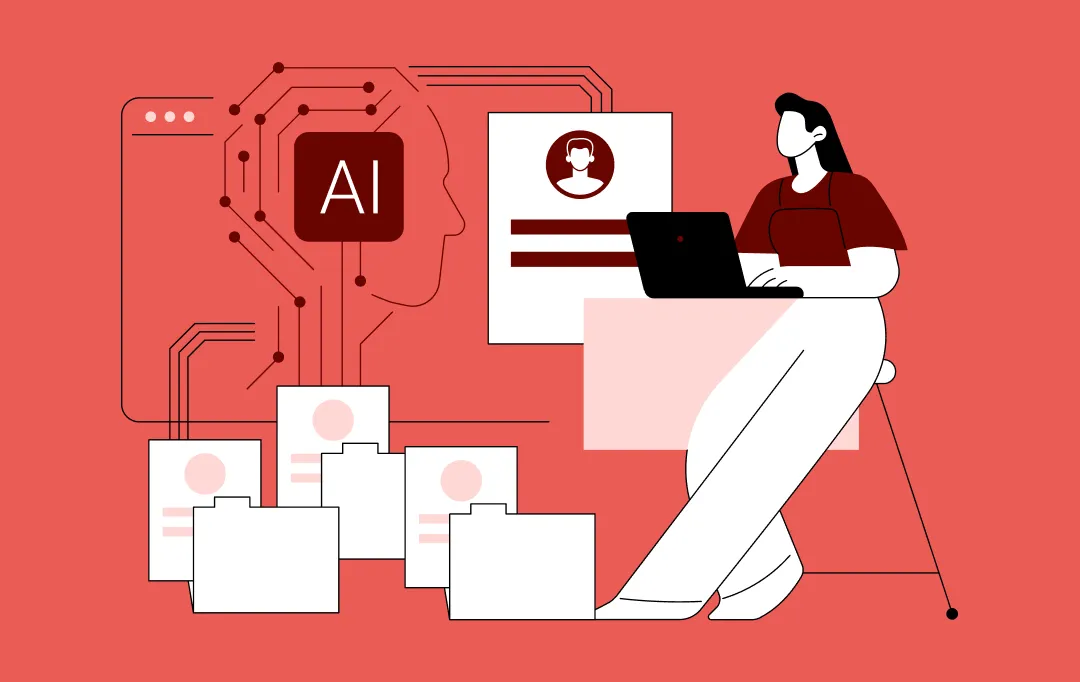
AI Predictive Analytics: The Executive's Blueprint for Proactive Growth
Key takeaways: Predictive intelligence shifts leadership from reacting to events toward anticipating outcomes Market adoption, infrastructure readiness, and data availability make this the right time to scale predictive capability Continuous, AI-powered prediction delivers significantly higher value than static historical analytics Business impact emerges only when predictive systems are embedded into core operations and workflows Organizational…
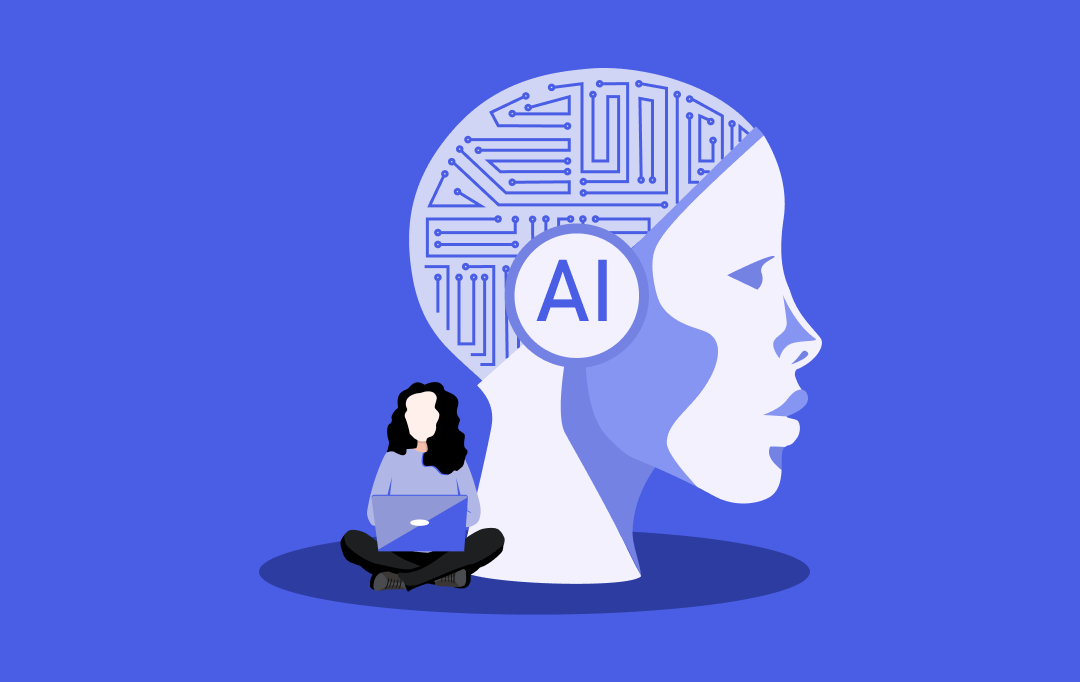
The Emergence of AI-driven Robotics: 14 Ground-Breaking Use Cases in Enterprises
Key Takeaways AI-driven robotics has shifted from automation tools to core operating infrastructure for enterprises. Intelligent robots now make decisions, not just execute instructions. Enterprises are adopting AI robotics at scale, not as pilots. Business impact shows up first in productivity, quality, and operational resilience. Integration and governance matter more than hardware. Companies that delay…
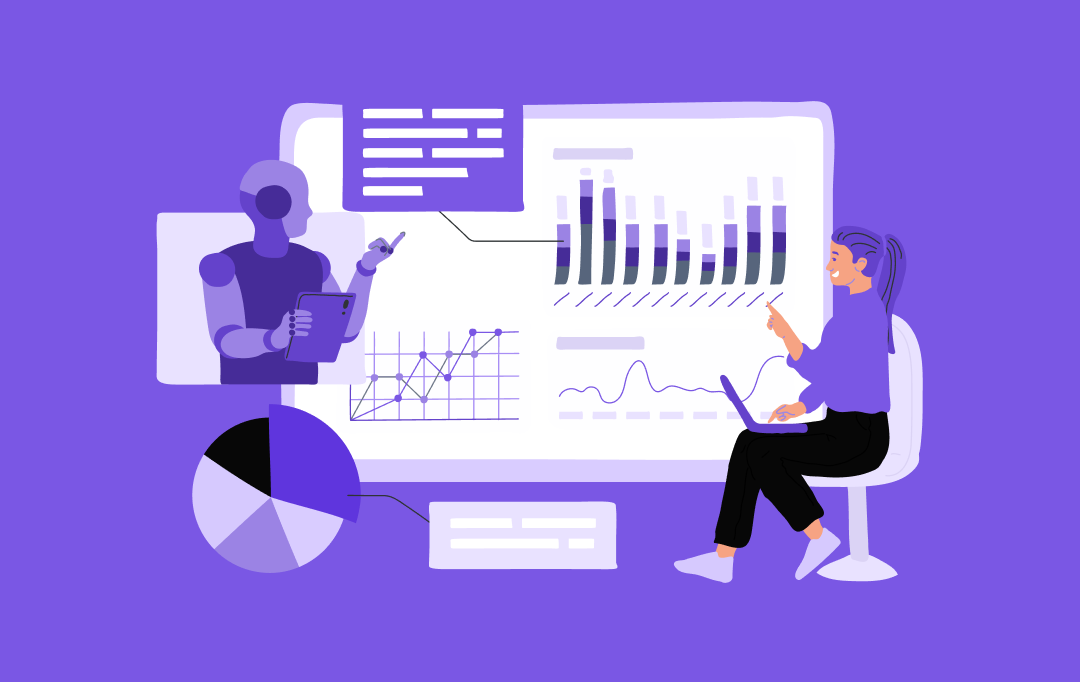
Why Enterprises Need AI Strategy Consulting in Dubai
Key takeaways: Dubai is moving fast with AI adoption. But many enterprises still struggle to move beyond pilots and achieve real business results. AI strategy consulting gives leaders a clear plan. From use-case selection to data readiness, so enterprise AI initiatives stay on track and within budget. AI consulting in Dubai helps enterprises reduce compliance…
